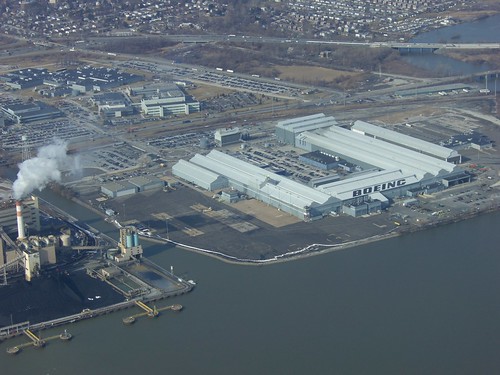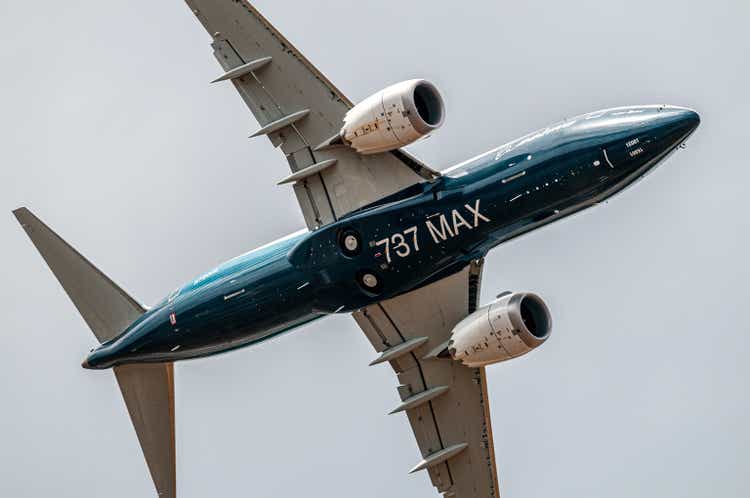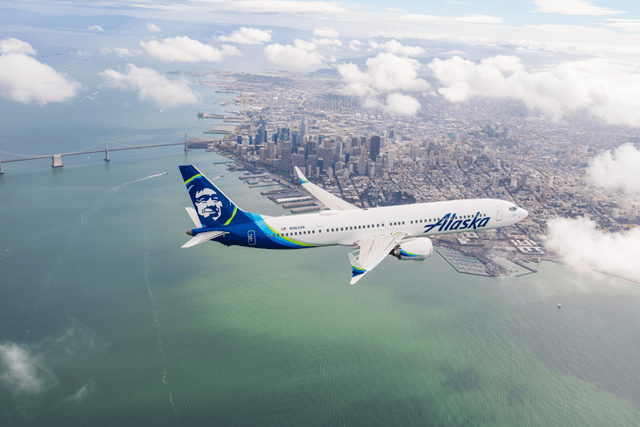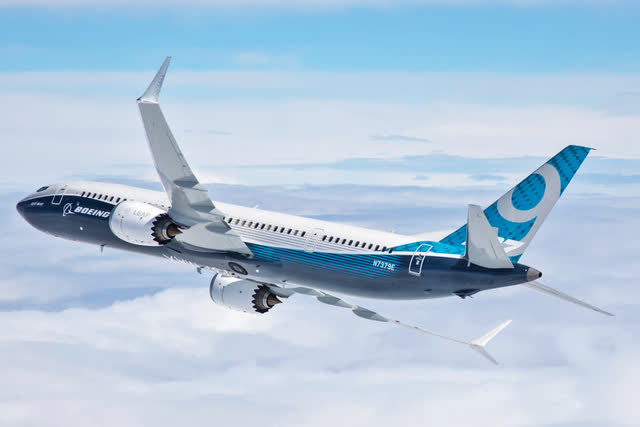Boeing: A New Explosive MAX And Stock Crisis?
Boeing #Boeing


Wirestock
On Friday, I published a report discussing the prospects for Boeing (NYSE:BA) from a cash flow perspective and concluded that the main cash flow drivers at Boeing’s Commercial Airplanes division hinged on the Boeing 737 MAX as well as the Boeing 787 delivery and production ramp-up execution as well as cost control on the Boeing 777X program. All of that depends on a rather smooth trajectory. A day later things are looking a bit different after a Boeing 737 MAX 9 suffered, what in the media is sometimes described as a window blowout or a window and part of the cabin being blown out. In this report, I discuss the incident and what it might mean for Boeing’s stock price.
New Boeing 737 MAX Suffers Explosive Decompression 
Alaska Airlines
A description of the incident is of importance. So, that is where I will start off. Shortly after taking off, a new Boeing 737 MAX 9 in commercial service for Alaska Airlines suffered what is known as an explosive decompression at an altitude of 16,325 feet but was able to return to Oregon safely with no casualties. When talking about explosions, some people are quickly thinking about fireballs but that is not necessarily the case and also was not the case for Alaska Airlines Flight 1282 which was on a scheduled service from Oregon to Ontario with 171 passengers and 6 crew members.
The airplane involved in the incident is registered N704AL and was delivered to Alaska Airlines on the 31st of October 2023, so it is a brand new jet. The fact that the jet is brand-new adds to the image formation that a manufacturing issue might be a contributing factor to the incident, but it is too early to draw any conclusions. The FAA and NTSB have launched investigations following the incident. The Air Current reported that the jet had suffered pressurization issues before triggering a removal from ETOPS services, which allows airplanes to operate routes where a point during the flight is more than one hour flying away from an alternate airport in one engine operative condition at cruise speed. However, the warning lights continued to indicate issues with pressurization issues in a subsequent flight.
Alaska Airlines Grounds All Boeing 737 MAX 9 Airplanes Followed by The FAA
In response to the incident aviation regulators initially did not ground the Boeing 737 MAX 9, but Alaska Airlines did ground all its 65 Boeing 737 MAX 9 airplanes to undergo a full maintenance and safety inspection. Ultimately, the FAA mandated the temporary grounding of the Boeing 737 MAX 9 operated by US airlines or in US territory via an Airworthiness Directive.
Investigation Likely To Focus On Deactivated Mid-Rear Door 
Boeing
The Boeing 737 MAX is Boeing’s cash cow as I recently discussed or better said one of Boeing’s two cash cows, so potentially there could be widespread ramifications if we just consider that this is an airplane of the MAX family. However, the explosive decompression occurred at the rear-mid door. The location of the decompression is important. I believe that is what the investigation will focus on to determine whether this is a manufacturing issue or something else. Besides that, I do believe that the investigation will also pay attention to Alaska Airlines’ handling of the warning light that illuminated hinting at pressurization issues on prior flights. One question that many will ask right now is why Alaska Airlines did not pull the jet from commercial service earlier after the pressurization issues persisted and only barred the airplane from ETOPS operations.
The fact that the issue occurred at the mid-rear door also significantly limits the scope in my opinion and that is because the Boeing 737 MAX 9 and the Boeing 737 MAX-8-200, which is the high-density variant of the Boeing 737 MAX 8, feature a mid-rear door. Our indications are that in 2023, Boeing delivered around 80 Boeing 737 MAX 9 airplanes and 68 Boeing 737 MAX-8-200 jets. Accounting for 21% and 17% for a total of 38% of all Boeing 737 MAX deliveries. That is still a significant number. Currently, Boeing has a backlog of over 4,500 Boeing 737 MAX airplanes of which 103 and 329 are for the Boeing 737 MAX 9 and Boeing 737 MAX-8-200.
I believe that the scope of the investigation and affected pool of airplanes could be further limited given that the explosive decompression occurred at what is known as a de-activated door. That is also why media reports and some passengers initially mentioned that a window and part of the cabin panel blew out. What essentially happened is that the entire plugged door or deactivated door blew out of the fuselage but from the inside it is not notable that this is a deactivated door.
Whether the door is activated or not depends on the configuration of the airline. When Boeing launched the Boeing 737-900ER, which is the predecessor to the Boeing 737 MAX 9 it added a pair of Type II exits which boosted the capacity of the Boeing 737-900ER from 189 to 215 seats. Over time advancing regulations and demonstrations allowed for an exit limit of 220 with a tolerance of one passenger which theoretically would allow seatings of up to 221 passengers.
Not all airlines require that additional door, which is merely there to cater to the exit limit for high-capacity configurations, and as a result, the door is deactivated. So, it is highly likely that the investigation will not be focusing on the mid-rear doors, but on the deactivated door which to my knowledge has a different installation procedure than an actual activated door. As a result, I believe that the scope will solely be on the Boeing 737 MAX 9 (with deactivated doors) of which Boeing has around 300 in backlog by November 2023 and over 200 airplanes delivered.
The Boeing 737-900ER, which no longer is in production, is likely exempt from the airworthiness directive issued by the FAA because the airplanes are old enough to have gone through the maintenance and inspections in which case the inspection of the plugged door has also been performed.
Who Are The Operators For The Boeing 737 MAX 9?
Boeing 737 MAX 9 Operator List
Operator
Delivered
Seats
Deactivated Doors
Aeroméxico
19
181
Yes
Air Tanzania
1
181
Yes
Alaska Airlines
65
178
Yes
Copa Airlines
29
166
Yes
Corendon Dutch Airlines
2
219
No
flydubai
3
172
Yes
Icelandair
4
178
Yes
Lion Air
3
221
No
Price Customer
1
VIP
Yes
Reliance Industries
1
VIP
Yes
SCAT Airlines
5
213
No
Turkish Airlines
5
169
Yes
United Airlines
79
179
Yes
Total
217
Click to enlarge
In total, there are 13 operators of the Boeing 737 MAX 9 operating a total of 217 jets, most of which do have deactivated doors. As a reference 1,425 MAX airplanes have been delivered, which means that the share of the airplanes with the deactivated doors covers the majority of the MAX 9 fleet and around 14.5% of the total MAX fleet.
How Many US Airlines Operate the Boeing 737 MAX 9?
With 79 airplanes delivered United Airlines is the biggest US operator of the MAX 9 followed by Alaska Airlines with 65 for a total of 144 airplanes US-registered Boeing 737 MAX 9 airplanes.
The Implications For Boeing Stock Price and Spirit AeroSystems
While the root cause of the incident and the chain of events has yet to be determined, I do believe that we might be seeing a price reaction in Monday’s trading session. In some way, for Boeing’s share price, it is a good thing that the incident occurred outside of market hours and on a Friday which gives days for investors to process the news for information to come online, and for investors to make a somewhat more informed decision on their investment. I don’t believe that we will be seeing a widespread grounding of the Boeing 737 MAX. A grounding for the Boeing 737 MAX 9 did happen after Alaska Airlines already grounded their fleet which represents a significant percentage of the MAX 9 fleet. Airplanes that recently already have gone through maintenance checks of which the inspection of the plugged doors is part can return to service without issue.
The fact that the AD puts a check as a prerequisite for a return to service shows a sign of confidence that no special actions besides the ones part of maintenance procedures are required to detect and address and potential issues regarding the deactivated door.
However, while I do not expect major lasting disruption to delivery flows the incident comes at a bad time for Boeing. There is never a good time for incidents I would say, but Boeing has been dealing with quality lapses in the supply chain last year triggering a downward revision on the delivery target for the Boeing 737 MAX and recently the company also mandated inspection for loose bolts in the tie rod of the rudder. So, the incident comes at a time when Boeing is already suffering together with Spirit AeroSystems from quality issues and also at a time when the US jet maker is looking for a waiver to comply with certain requirements to get its MAX 7 and MAX 10 models certified. This incident, while in nature not related, adds more pressure on aviation regulators to not provide a waiver and at this time it puts yet another question mark behind Boeing’s quality assurance process.
I do expect that we will be seeing some selling because Boeing has been falling from one problem into another it seems and at some point, investor patience and confidence in management is exhausted. Boeing stock rose from a 52-week low of $176.25 to a 52-week high of $267.54 representing more than 50% growth in stock prices and more than 40% at the current price level. I believe that the latest incident will cause some profit-taking in Boeing share prices as well as the stock price of Spirit AeroSystems which has more than doubled from the bottom.
So, while I do not expect widespread impact I do expect profit taking in BA and SPR stock as investors might develop fatigue from the ongoing issues at Boeing and Spirit products that give the impression that Boeing management is not on top of things and it also might make investors wonder whether the entire supply chain, quality system and assembly line is up for the planned production hikes.
Conclusion: Boeing Stock Got Riskier, But Long-Term Buying Opportunity Can Present Itself
In my previous report covering Boeing, I showed what cash flow drivers Boeing has up its sleeve and reiterated my buy rating. Just a day later, I am warning about selling Boeing stock and you might think “Well, Dhierin make up your mind.” The reality is that I do not control news flow and there are various investment horizons. In some way, maybe we should also appreciate how far the safety of the industry has come. We are less than one week into 2024 and had one Airbus A350 hull loss without casualties and an explosive decompression of a Boeing 737 MAX airplane without casualties. It is not the start you would want, but overall we do see how evolving design and regulations are positively impacting the industry.
Short-term we might see some pressure on Boeing’s stock price but granted that the scope and impact are limited and possibly have extremely limited consequences for Boeing’s deliveries in 2024 I do believe that the longer-term picture remains intact and stock price weakness could offer a nice long-term entry point.
At the same time, while the Boeing 737 MAX airplane landed safely and that is what it is supposed to do even during an incident the latest incident to me shows that Boeing is not yet on top of its game and it makes me wonder what the current CEO did the past years to improve the quality and oversight at Boeing. Cash flow targets are nice, but it all starts with having a good product and a strong quality mechanism in place.